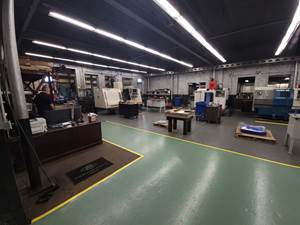Key CNC Concept #9—The Key Sequences Of Operation
This concept examines the sequences of operation of a CNC machine by way of reference material related to key operational procedures.
This is the ninth article in a 10 part series about the key concepts of CNC. To start at the beginning, read this article.
Experienced operators would agree that running any CNC machine tool is little more than following a series of basic procedures. From powering the machine up in the morning to turning it off at night, the operator will be following these sequences in a step-by-step manner.
From the beginning operator's standpoint, half the battle of learning how to operate a CNC machine is simply knowing when each procedure is required. Then, it will be a simple matter to follow the basic sequence to attain the machine's desired function. For example, if an operator wishes to load a program into the control memory, there are a series of switches and buttons that must be activated in the proper order. If the operator wishes to change an offset, a specific procedure must be followed. While the actual buttons and switches will vary depending on the control model, once the operator has documented the most important sequences, it is relatively easy to make the machine function in the desired manner.
Too many companies that utilize CNC expect their operators to memorize all key procedures needed to run the machine. We strongly recommend that the CNC user develop an operation handbook in order to help operators become comfortable with each CNC machine tool (one per machine). This will give the operator the step-by-step procedures needed for critical machine operations.
The Most Important Sequences
Procedures like powering up, powering down, loading tools, setting offsets, and editing programs are among the things an operator will be doing on a regular basis and should strive to memorize. However, there are also procedures that are used less often that should also be documented. Again, the operations handbook should give the operator every procedure needed to run the machine.
These procedures make it very easy to operate your CNC machine. They provide quick and easy reference material related to key operational procedures. While it would be nice if each CNC machine tool builder incorporated this kind of handbook for every machine they sell, few builders do. For most CNC machines, you will have to develop this information on your own.
You can divide your procedures into logical categories. Here is a specific list of procedures we would recommend you develop for a typical CNC machining center. Very similar procedures would be required for any form of CNC machine tool. If the operator has this kind of information at his or her fingertips while learning to run a CNC machine tool, running the machine will be much easier!
Manual Sequences
- To start machine
- To do a manual reference return
- To manually start spindle
- To manually jog axes
- To use the handwheel to cause axis motion
- To manually load tools into spindle
- To manually load tools into magazine
- To manually turn on coolant
- To make axis displays read zero or any number
- To enter tool offsets (length and radius)
- To manually turn on mirror image
- To manually select inch or metric mode.
Manual Data Input Sequences
- To use MDI to change tools
- To use MDI to turn on spindle
- To use MDI to do a reference return
- To use MDI to move axes.
Program Loading And Saving Sequences
- To load programs into memory by tape
- To load programs into memory by RS-232 port
- To load programs into memory through keyboard
- To punch programs from memory to tape punch or computer.
Program Display And Editing Sequences
- To display a directory of the programs in memory
- To delete a whole program from memory
- To search other programs in memory
- To search to words inside a program
- To alter words in memory
- To delete words and commands in memory
- To insert words and commands in memory.
Setup Sequences
- To measure program zero positions
- To measure tool length information.
Program Running Sequences
- To verify programs
- To run verified programs in production
- To run from the beginning of any tool.
This is the ninth article in a 10 part series about the key concepts of CNC. To start at the beginning, read this article.
Next Article - Key Concept Number 10 - Verifying CNC Programs Safely.
Related Content
Swiss-Type Control Uses CNC Data to Improve Efficiency
Advanced controls for Swiss-type CNC lathes uses machine data to prevent tool collisions, saving setup time and scrap costs.
Read MoreUnderstanding G27, G28, G29 and G30
Take a closer look at these reference position commands.
Read MoreFrom Tradition to Transformation: Century-Old Manual Machine Shop Adds CNCs
After 122 years of working with manual mills and lathes, this fifth-generation shop acquired assets of a local CNC machining business and hired the owner. Here’s how it’s going a year later.
Read MoreHow this Job Shop Grew Capacity Without Expanding Footprint
This shop relies on digital solutions to grow their manufacturing business. With this approach, W.A. Pfeiffer has achieved seamless end-to-end connectivity, shorter lead times and increased throughput.
Read MoreRead Next
3 Mistakes That Cause CNC Programs to Fail
Despite enhancements to manufacturing technology, there are still issues today that can cause programs to fail. These failures can cause lost time, scrapped parts, damaged machines and even injured operators.
Read More
.jpg;width=70;height=70;mode=crop)












.png;maxWidth=300;quality=90)










